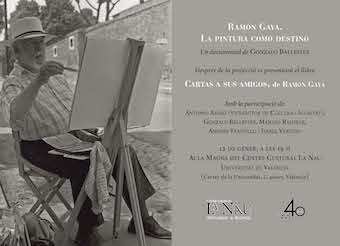
Cultural Centre La Nau will hold this Thursday 12 January the presentation of a book and a documentary about the painter and writer Ramón Gaya (Murcia, 1910-2005). The act will take place at 19 hours in the Aula Magna of the Cultural Centre and will count with the participation of Antonio Ariño, Vice-Principal for Culture and Equality; Gonzalo Ballester, filmmaker; Manuel Ramírez, editor; Andrés Trapiello, writer; and the editor of the book Isabel Verdejo, who is the painter’s widow.
A documentary by Gonzalo Ballester, ‘Ramón Gaya. La pintura como destino’ was broadcast a few months ago in the TV programme ‘Imprescindibles’ in the 2 RTVE channel. This is the second film that the young filmmaker dedicates to Ramón Gaya, who not only lived in the same region as him but was also his friend. The first one was dedicated to the painter’s ‘Journals of Venice’ is titled ‘La Serenissima’. It was produced in 2006 and was nominated in the “Best Short Film” category of the Goyas 2007 edition.
After the projection of the documentary, the book ‘Cartas a sus amigos’ (‘Letters to his friends’) (Pre-Textos, 2016) of Ramón Goya will be presented. Many of these letters may be considered of the same nature and importance as the essays of the painter from Murcia, the same way he considered the connexion between the drawings of Rembrandt and Goya and their paintings.
According to Andrés Trapiello, “when skimming them, it feels like these letters are an autobiography, or at least a self-portrait. What is strange about this involuntary autobiography (there is nothing further of Gaya than himself aiming to tell us about his life) is that it is composed by barely some letters that were written in different moments without continuity. Despite that, we can imagine his whole life through these letters, as if it was a little fractal. I think that those who did not meet Ramón Gaya in person can get an idea on how his personality was. Definitely, this is an ensemble that gives us some sort of “autobiographical” sequence of the writer and painter from Murcia.
The act is co-organised by the Universitat through the Office of the Vice-Principal for Culture and Equality and the Editorial Pre-Textos on the occasion of its 40 anniversary.
About Ramón Gaya
Ramón Gaya was born in Huerto del Conde (Murcia) in 1910 in the heart of a family that was characterised by a reading and general culture vocation. Very influenced by this circumstance he left school at the age of ten to dedicate himself entirely to painting, following the advice of the painters from Murcia Pedro Flores and Luis Garay. He enters the art world at that age presenting a regional collective exposition organised by the Circle of Fine Arts of Murcia. He had his first contact with the modern art world through some English painters who brought copies of what was being done in Paris in that specific moment, like for example Picasso’s, Braque’s and Matisse’s work.
The poet Jorge Guillén arrived in Murcia in 1926 and founded along with Juan Guerrero Ruiz the journal ‘Verso y Prosa’, in which many writers of the so-called Generation of ‘27 took part, like e.i Lorca, Alberti, Aleixandre, Altolaguirre or Cernuda among others including Gaya himself, who collaborated with illustrations and writings.
During his youth he travelled to Paris to take a first-hand look at the work of trendy innovators and to see them was an incredible disappointment, so he turned his sight at the Museo of Prado, where the work of artists like Tiziano, Rembrandt, Velázquez or Rubens could be found ─ since then, his pictorial references and masters.
The Spanish Civil War was one of the most dramatic occurrences that he had to face. From the very first moment he served the Republic and took part in the legendary Valencian journal ‘Hora de España’, working as the only cartoonist. Authors like Antonio Machado, María Zambrano, Bergamín or Luis Cernuda wrote in this journal.
The end of the war was a hard blow not only because the defeat of the Republican side, but also because the death of his wife in a bombardment. After his stay in a French concentration camp he managed to arrive in Mexico, where he spent seventeen years in exile. His artistic production enlarges in a very important way while there and he pays most of his tributes to masters like Tiziano, Picasso, Velázquez, Van Gogh, Cézanne or Rembrandt.
Gaya made exhibitions in numerous art galleries. Among the prizes he won stand out the National Visual Arts, given in 1997; the Golden Medal of the Madrilenian Circle of Fine Arts, the appointment of Ramón Gaya in 1992 as Honorary Doctorate of the University of Murcia or the Velázquez Prize in 2002. Ramón Gaya died in 2005 at his home in Valencia.
Last update: 11 de january de 2017 10:47.
News release


















